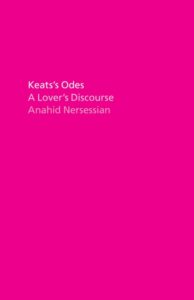Anahid Nersessian looks at Keats’s six great odes with a contemporary eye
You never quite know what you’re going to get yourself into these days with literary criticism.
I should say up front that I belong to an old school of literature. I wasn’t an English major, but I sat with them through two semesters of English Lit in college, while 99.999 percent of the other students took the general, mainly American, literature courses. My two-volume Norton Anthology of English Literature, now more than half a century old, sits on a bookshelf, complete with my underlines and marginal scribblings. I still use my Norton as a reference, and I may ask to have it buried with me when the time comes. I even have my textbook from high school senior English, and I still use it as a reference as well.
My midterm exam in second-semester English lit was three pages of lines and phrases from the poetry of John Keats, William Wordsworth, Samuel Taylor Coleridge, Percy Shelly and George Lord Byron — and I had to identify the author of each line or fragment. Some of the English majors flunked the exam. No one got an A. I was downright thrilled to get a B-.
I read a lot of poetry, and I read, or used to, a lot of general literary criticism. But I find myself reading less criticism than before. It’s changed, profoundly so. Much of it is now written through various “lenses,” lenses of topical and usually political shades. Perhaps this is what academic critics have to do these days, if they want their work accepted and printed by academic and general publishers.
 I began reading Keats’s Odes: A Lover’s Discourse by Anahid Nersessian knowing two things. First, the author is a professor of English literature at UCLA. She’s also written The Calamity Form: On Poetry and Social Life (2022) and Utopia, Limited: Romanticism and Adjustment (2015), and she’s been published in numerous scholarly journals.
I began reading Keats’s Odes: A Lover’s Discourse by Anahid Nersessian knowing two things. First, the author is a professor of English literature at UCLA. She’s also written The Calamity Form: On Poetry and Social Life (2022) and Utopia, Limited: Romanticism and Adjustment (2015), and she’s been published in numerous scholarly journals.
The second thing I knew when I began reading, judging by the book description, was that she loves Keats. After finishing her book, I would say that, yes, she does indeed love Keats.
What surprised me was that the work is a self-described feminist/Marxist analysis of Keats’s six odes. That was not in the book description.
Nersessian is an excellent, engaging writer, even for non-academics like myself. She doesn’t write in academic jargon, and I think it was that, more than anything, that convinced me to read the book through to the end.
And so you know, some of the brightest of the literary lights raved about the book. The Boston Globe named it one of the best books of 2021. It was a finalist for the Poetry Foundation’s Pegasus Award for criticism. It received raves from Commonweal, The Nation, The Los Angeles Review of Books, the Times Literary Supplement, the Washington Post, and Publishers Weekly.

Anahid Nersessian
Neanderthal Baby Boomer that I am, my first thought, as I began reading, was that Karl Marx wasn’t even 3 years old when Keats died of tuberculosis in Rome. I know, I’m a cretin; I don’t understand how Marxist criticism works. My second thought was that Marxist thought, in practice or real life, was responsible for the deaths of tens of millions of people. I know, I’m worse than a cretin; I’m a conservative cretin.
What almost killed the book for me were the discursions into the personal. I didn’t need to know about the graphic pictures a former boyfriend sent by text. Too much information there. And I didn’t understand the connection of the texts to Keats. But, still, I read on. And I finished it. I’m actually glad I did.
I can repeat that Nersessian does indeed love Keats’s poetry. She lives and breathes his words and lines. She does offer fine insights into his work, aside from the Marxist and feminist lenses. And Keats has gotten her through some tough experiences.
I love Keats’s poetry as well, but I exist in a very different world. I love how he uses language. I love the sheer beauty of his poems. I thoroughly enjoy reading about the Romantic period and Keats’s place within it. And the romantic tragedy of his illness and death, leaving his great love Fanny Brawne behind, breaks my heart.
And I know I have reached the age where I can disregard the lenses of Marx and the others, and I can leave the contemporary critics to offer and enjoy other kinds of interpretations.
But I wonder whether they really enjoy what a poet like Keats has to say, beyond their own personaI concerns (and phone texts). I think what I’m trying to say is that the work of Keats and other great poets exists beyond our current lenses, feelings, and experiences. They are great poets because of their command of language and how they continue to speak to the human condition, and that’s more important than all the various lenses in the world combined.
I hope that’s something we never forget.
Related:
A Month with Keats: A Walk into His Life
A Month with Keats: Keats and Hampstead Heath
A Month with Keats: Poetry, Religion, and Politics
A Month with Keats: Keats and Wentworth House
Photo by llee_wu, Creative Commons, via Flickr. Post by Glynn Young.
How to Read a Poem uses images like the mouse, the hive, the switch (from the Billy Collins poem)—to guide readers into new ways of understanding poems. Anthology included.
“I require all our incoming poetry students—in the MFA I direct—to buy and read this book.”
—Jeanetta Calhoun Mish
- “Horace: Poet on a Volcano” by Peter Stothard - September 16, 2025
- Poets and Poems: The Three Collections of Pasquale Trozzolo - September 11, 2025
- Poets and Poems: Boris Dralyuk and “My Hollywood” - September 9, 2025


Mary Sayler says
Good article, Glynn – timely too and the ending excelled: “…the work of Keats and other great poets exists beyond our current lenses, feelings, and experiences. They are great poets because of their command of language and how they continue to speak to the human condition, and that’s more important than all the various lenses in the world combined.” Amen!
I’m so glad to see this topic addressed. We seem to be in a time when people in general have become judgmental without meaning to, simply because they hold other eras and ages to views commonly accepted today.
Glynn says
Mary, thank you. I often wonder how future generations, including my grandchildren, will look back on this era.